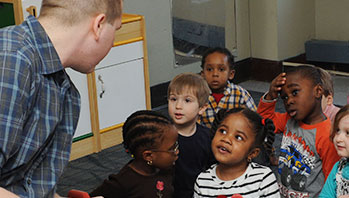- clear container of water (for demonstration)
- collection of balls (for example, ping pong, golf, tennis, rubber, whiffle, lacrosse, bocce, etc.)
- paper towels (for spills)
- camera or cell phone with camera
- float
- sink
MA Standards:
Speaking and Listening/SL.PK.MA.1: Participate in collaborative conversations with diverse partners during daily routines and play.
Language/L.PK.MA.6: Use words and phrases acquired through conversations, listening to books read aloud, activities, and play.
Head Start Outcomes:
Language Development/Receptive Language: Attends to language during conversations, songs, stories, or other learning experiences.
Language Development/Expressive Language: Uses language to express ideas and needs.
Logic and Reasoning/Reasoning and Problem Solving: Classifies, compares, and contrasts objects, events, and experiences.
PreK Learning Guidelines:
English Language Arts/Language 2: Participate actively in discussions, listen to the ideas of others, and ask and answer relevant questions.
Talk Together: What Floats? What Sinks?

© Commonwealth of Massachusetts, Department of Early Education and Care (Jennifer Waddell photographer). All rights reserved.
STEM Key Concepts: Objects behave differently in water; Some things float; Some things sink; If you add enough weight to a floating object, it will sometimes sink; Solids have physical characteristics that can be observed and described
ELA Focus Skills: Compare and Contrast, Follow Directions, Listening and Speaking, Vocabulary
Educator Prep: Before the activity prepare a 3-column chart with the column heads: “Ball;” “Prediction: Float—Sink;” and ”What happened?”
Ask children to share things they observed at home that float or sink. If children have brought items in, allow them to demonstrate and describe what happened when they placed them in the water. Discuss why children think some objects float and some sink.
- Pass the golf ball around and invite children to look at it and feel it. Draw attention to the chart. Ask, Do you think this <golf ball> will float or sink in the water? Hold up your hand if you think it will float. Count the number of hands raised and record it on the chart (or have a volunteer record it on the chart). Ask children to talk about why they think it will float or sink.
- Then have children who think it will sink raise their hands and record the number on the chart. Continue with the remaining balls.
- Hold up the sponge ball last and record children’s predictions.
- Tell children you will revisit the chart to check their predictions after they have had time to observe the balls in the water.
English Language Learners: Tap into the prior knowledge of children, who might have unique experiences to share with the class.
